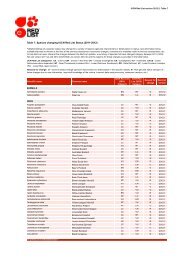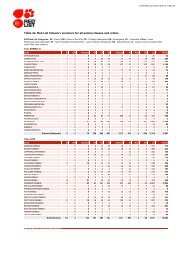IUCN Red List Guidelines - The IUCN Red List of Threatened Species
IUCN Red List Guidelines - The IUCN Red List of Threatened Species
IUCN Red List Guidelines - The IUCN Red List of Threatened Species
Create successful ePaper yourself
Turn your PDF publications into a flip-book with our unique Google optimized e-Paper software.
<strong>Red</strong> <strong>List</strong> <strong>Guidelines</strong> 22<br />
or preventing reproduction, should be counted as one mature individual. Obviously, what<br />
such an entity would be is <strong>of</strong>ten not known. <strong>The</strong>refore, in such cases, it may be necessary to<br />
adopt a pragmatic approach to defining ‘mature individuals’. Examples <strong>of</strong> possible<br />
interpretations <strong>of</strong> the definition <strong>of</strong> a mature individual are:<br />
• For diffuse, wholly visible organisms in continuous habitats (e.g., corals, algal mats)<br />
assessors may assume an average area occupied by a mature individual and estimate the<br />
number <strong>of</strong> mature individuals from the area <strong>of</strong> occupied habitat. <strong>The</strong> area <strong>of</strong> occupied<br />
habitat should be estimated at a scale (grid size) that is as close as practicable to the area<br />
assumed to be occupied by a single mature individual (not necessarily 2x2 km as<br />
recommended for estimation <strong>of</strong> AOO).<br />
• For diffuse organisms, not wholly visible, in continuous habitats (e.g., subterranean<br />
mycelial fungi) assessors may assume that each recorded presence separated by a<br />
minimum distance represents an assumed number <strong>of</strong> individuals. For example, each<br />
visible fungal fruiting body may be assumed to represent ten mature individuals, so long<br />
as they are separated by at least 10 metres. This kind <strong>of</strong> assumption is necessary because<br />
the size or area <strong>of</strong> a fungal mycelium is rarely known.<br />
• For diffuse organisms that occur in discrete habitat patches (e.g., fungi living more or<br />
less concealed in dead wood), each patch (trunk or log colonized by the species) could –<br />
if no better information exists – be counted as 2–10 mature individuals, depending on<br />
the size <strong>of</strong> the tree.<br />
In any case, it is recommended that authors <strong>of</strong> <strong>Red</strong> <strong>List</strong> assessments specify the way they<br />
have used ‘mature individual’.<br />
4.3.3 Fishes<br />
In many taxa <strong>of</strong> marine fish, reproductive potential is commonly closely related to body size.<br />
Since exploitation usually reduces the mean age and size <strong>of</strong> individuals, assessing declines in<br />
numbers <strong>of</strong> mature individuals may under-estimate the severity <strong>of</strong> the decline. When<br />
evaluating population decline, this factor should be kept in mind. One possible method is to<br />
estimate decline in the biomass <strong>of</strong> mature individuals rather than the number <strong>of</strong> such<br />
individuals when applying criterion A, where biomass is ‘an index <strong>of</strong> abundance appropriate<br />
to the taxon’.<br />
4.3.4 Sex-changing organisms<br />
Many marine taxa have the capacity to change sex as they grow. In such taxa, the sex ratio<br />
may be highly biased towards the smaller sex. <strong>The</strong> criteria acknowledge that the number <strong>of</strong><br />
mature individuals can take biased sex ratios into account, by using a lower estimate for the<br />
number <strong>of</strong> mature individuals. For sex-changing organisms it is also appropriate to consider<br />
changes in sex ratio as an indicator <strong>of</strong> population perturbation, which may be <strong>of</strong> additional<br />
conservation concern because the larger sex (already less numerous) is <strong>of</strong>ten subject to<br />
higher harvest mortality. In these cases, the number <strong>of</strong> mature individuals may be estimated<br />
by doubling the average number <strong>of</strong> individuals <strong>of</strong> the larger (or less numerous) sex.






